Exciting Rajasthan Forts in addition to Palaces explain to your bygone time regarding past regal seat of the Rajputs. This Rajputs much like the Mughals were being resourceful constructors and have patronized some of the most illustrious in addition to impressive forts in addition to palaces throughout Rajasthan. Nearly every location of the breathtaking sweet area Rajasthan is lined having incredible forts in addition to palaces developed simply by several rulers in addition to architects. These forts in addition to palaces were being usually developed away from the walled location in the substantial hillsides to shield the location.
This wonder will be properly conserved within the folks of Rajasthan along with within the regal forts along with palaces. Everlasting this unmerciful leave really agitates along with oppressing heat from the sizzling sun's rays, they've got was unshakable against many-a-sieges and have absolutely supplied protection towards rulers into their moment of struggle. Right now, they are opened up towards tourists whom occur below to discover a great display with their abundant customs along with outstanding inspired buildings. Several forts along with palaces hold on to their particular previous attract along with schedule. Many of the noble homes have been today become customs motels, in which the visitors can easily still have the miracle of India's imperial previous.
Famous Forts
Best Time to Visit - Amer Fort : October- March
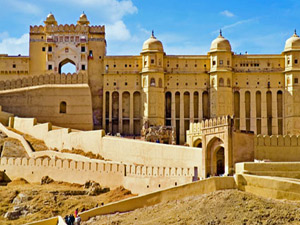 Amber Fort is sited at the town of Amber, 11 kms from the capital city of Rajasthan, Jaipur. The former rulers of Amber used it as their fortress till they shifted the capital to Jaipur. Raja Man Singh I began construction in 1592 but it was Sawai Jai Singh who completed it. Amber Fort Palace looks rugged on the outside but once get inside visitors are enthralled by the scrupulous intricate works of murals and frescoes, paintings from scenes of everyday life, carvings, mosaic and detailed minute mirror work splattered all over the walls. The architectural wealth of the fort is no surprise considering the fact that it was designed based on both Hindu and Mughal elements. Huddling on the hilltop, the fort showcased some unique work of delicate glass mirrors on the walls and ceiling that reflect the golden rays of the sun all over the premises. The fascinating royal elephant ride up to the fort is quite seductive and a real attraction for the tourist.
Amber Fort is sited at the town of Amber, 11 kms from the capital city of Rajasthan, Jaipur. The former rulers of Amber used it as their fortress till they shifted the capital to Jaipur. Raja Man Singh I began construction in 1592 but it was Sawai Jai Singh who completed it. Amber Fort Palace looks rugged on the outside but once get inside visitors are enthralled by the scrupulous intricate works of murals and frescoes, paintings from scenes of everyday life, carvings, mosaic and detailed minute mirror work splattered all over the walls. The architectural wealth of the fort is no surprise considering the fact that it was designed based on both Hindu and Mughal elements. Huddling on the hilltop, the fort showcased some unique work of delicate glass mirrors on the walls and ceiling that reflect the golden rays of the sun all over the premises. The fascinating royal elephant ride up to the fort is quite seductive and a real attraction for the tourist.
The Amer fort is built in red sandstone and white marble. The entrance to the fort is through the Suraj Pol which opens into the Jaleb Chowk, the main courtyard.
The most prominent structures inside the Amer fort is the Diwan-i-Aam or the Hall of Public Audience. The Diwan-i-Khas or the Hall of Private Audience was a special place where the king met and discussed important issues with respected dignitaries from his court and outside. The grace of the hall is enhanced by the mirror work that adorn the ceiling.
Other masterpieces include in the Fort are Sheesh Mahal, Jai Mandir, The Sukh Niwas. There are two temples in the Amer fort complex too. The first one of these, a small Kali temple is the place where Maharaja Man Singh prayed before he left for any war. The second temple, Shila Mata Temple. According to beliefs, the deity that is placed in the temple was brought specially by Raja Man Singh from Jessore in East Bengal (now Bangladesh).
Dil-i-Aaram Garden and Kesar Kyari garden are the two worth seeing gardens in the Amer fort complex. The Dil-i- Aaram Garden also houses the Archaeological Museum of Amer which is divided into three section - archaeological, sculpture and epigraphy. There is also an art gallery in the fort complex.
Best Time to Visit Jaigarh Fort : October- March
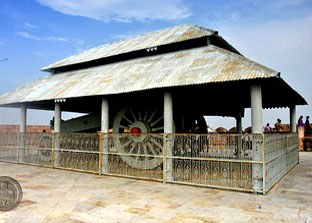 The Jaigarh Fort, located on one of the peaks of the Aravalli range of hills is built about 400 m above the Amber Fort. It provides an excellent view of Aravalli hills and the Amber Fort down below. The fort, rugged and similar in structural design to the Amber Fort, is also known as Victory Fort. The fort features a cannon named Jaivana, which was manufactured in the fort confines and was then the world's largest cannon on wheels. The palace complex (Laxmi Vilas, Lalit Mandir, Vilas Mandir and Aram Mandir) located within the fort has a well-tended garden where the royal family resided, the Shubhat Niwas (an assembly hall of the warriors), an armory and a museum.
The Jaigarh Fort, located on one of the peaks of the Aravalli range of hills is built about 400 m above the Amber Fort. It provides an excellent view of Aravalli hills and the Amber Fort down below. The fort, rugged and similar in structural design to the Amber Fort, is also known as Victory Fort. The fort features a cannon named Jaivana, which was manufactured in the fort confines and was then the world's largest cannon on wheels. The palace complex (Laxmi Vilas, Lalit Mandir, Vilas Mandir and Aram Mandir) located within the fort has a well-tended garden where the royal family resided, the Shubhat Niwas (an assembly hall of the warriors), an armory and a museum.
The fort is 15 km away from Jaipur city. It stands on a short diversion from the Jaipur-Delhi Highway, which leads to the Jaivana cannon at the Dungar Gate. It can also be approached from the Amer Fort over a short climb along a steep hill track, arriving at the Awami Gate near the fort museum. Jaigarh Fort gives some spectacular views of Jaipur and Amber Fort from the Diwa Burj watchtower. There were rumors that there was a large treasure of gold buried in the premises of the fort. Thus, it had to be sealed from the public for seven long years. Now, it has been opened to the public to display its several beautiful palaces, gardens, its granary, an armory which has a stunning collection of arms and weapons and its temples.
Best Time to Visit Nahargarh Fort : October- March
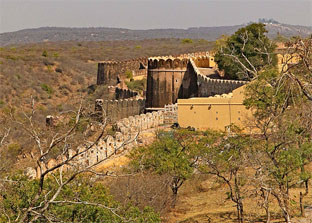 Nahargarh Fort has its own significant place in history. Built by Sawai Raja Jai Singh in the year 1734 and located on the Aravalli hills, the Fort was required to strengthen the protective coverage of Amber, the capital of the earlier rulers of Jaipur. Further extension and expansion work was done in the fort by later rulers and it is these additions that today hold the attention of the tourists. Nahargarh Fort has an interesting tale attached to its construction. It is said that the fort was haunted by a spirit of a prince called Nahar. He made sure that an obstruction occurred every time the construction of the fort progressed smoothly. Eventually, a saint prayed to the spirit of the prince who agreed to leave only on the condition that the fort was named after him.
Nahargarh Fort has its own significant place in history. Built by Sawai Raja Jai Singh in the year 1734 and located on the Aravalli hills, the Fort was required to strengthen the protective coverage of Amber, the capital of the earlier rulers of Jaipur. Further extension and expansion work was done in the fort by later rulers and it is these additions that today hold the attention of the tourists. Nahargarh Fort has an interesting tale attached to its construction. It is said that the fort was haunted by a spirit of a prince called Nahar. He made sure that an obstruction occurred every time the construction of the fort progressed smoothly. Eventually, a saint prayed to the spirit of the prince who agreed to leave only on the condition that the fort was named after him.
The Fort, is also known as the Tiger Fort. On the top of the hill, the beautiful Man Sagar Lake spreads a welcoming glance. Right in the middle of the lake, Raja Jai Singh II built a duck blind, a shelter for screening duck hunters, for his shooting parties. The prime attraction of the Nahargarh Fort is the Madhavendra Bhavan which was the summer retreat of the royal family. The structure was built by Sawai Ram Singh II in 1880s and boasts of 12 completely alike suites for the use of queens. The suite of the king was constructed at a convenient place so that he could visit his queens without any hassles.
This pleasure palace is one of the most loved picnic spot today. It offers a perfect retreat for all those who wish to spend some quiet moments with themselves. The tranquility offered by the fort draws many tourists from far and wide.
Ranthambore National Park & Fort (Sawai Madhopur)
Best Time to Visit Ranthambore National Park & Fort (Sawai Madhopur) : November - May
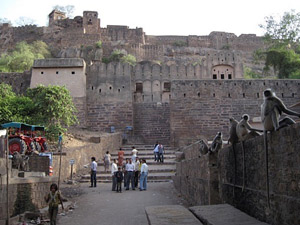 The Ranthambore Fort was built during the 8th century by the Chauhans. The Ranthambore Fort is situated in the lush greenery of the Ranthambore National Park atop a hill. The name Ranthambore draws from the name of the hills - Thanbhore is the hill on which the fort is situated and Ran is the nearby hill.
The Ranthambore Fort was built during the 8th century by the Chauhans. The Ranthambore Fort is situated in the lush greenery of the Ranthambore National Park atop a hill. The name Ranthambore draws from the name of the hills - Thanbhore is the hill on which the fort is situated and Ran is the nearby hill.
The fort was attacked by a number of big powers at different point of time in history. Finally, the fort was captured by the Mughals who earlier used it as a staying place and later as a prison fortress. In the 19th century, the fort was given back to the Maharaja of Jaipur and it remained with them till the time India gained independence in the year 1947.
For tourists visiting the Ranthambore Fort, it is advisable to keep enough time on hand. It is partly because of the reason that there is no pathway approaching the fort which means that visitors need to climb up the stairs of the hill to reach it. The fort has so much to offer in terms of attractions that time will fly out without even giving a slightest of clue of its passage. The other plus point of the fort is that its location in midst of the wildlife sanctuary ensures that there is neither any entry fee nor any over anxious guide to trouble the visitors.
The attractions of Ranthambore Fort caters to the varying interests of the tourists. For those who love history, the fort has unending stories to narrate while for people with religious bent of mind, there are numerous big and small temples. Lastly, those visitors who are interested in wildlife adventure, there is the breathtaking view of the Ranthambore National Park. Animals rambling lazily to drink water from the lake below arouse an entirely different kind of feeling in the visitors.
One of the oldest forts in India, the Ranthambore Fort spreads over an area of 7 kms in circumference and occupies a group of buildings like palaces, temples, mosques and barracks enthuse the visiting tourists.
The Hammir court is the prime attraction of the Ranthambore Fort. The Ganesh Temple is not to be missed by the religious people. An interesting aspect about the temple relates that devotees write letters to Lord Ganesha and send it to this temple. These letters are delivered daily by the local postman.
The Gupt Ganga, a stream that continues to flow throughout the year. Other attractions inside the Ranthambore Fort include Toran Dwar, Mahadeo Chhatri, Sameton Ki Haveli, 32 pillared Chhatri, and a Mosque.
Best Time to Visit Chittaurgarh Fort (Udaipur) : October- March
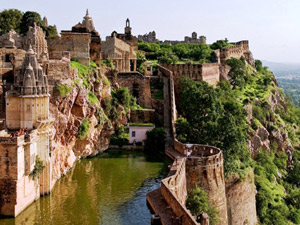 Chittaurgarh Fort, situated in the state of Rajasthan was built between the 5th and the 8th century by the Mori Rajput ruler, Chitrangad. It was known Chitrakot at that time. Later, Sisodia Rajput ruler, Ajai Pal Chauhan made some amendments in it.
Chittaurgarh Fort, situated in the state of Rajasthan was built between the 5th and the 8th century by the Mori Rajput ruler, Chitrangad. It was known Chitrakot at that time. Later, Sisodia Rajput ruler, Ajai Pal Chauhan made some amendments in it.
The Fort has witnessed three bloody sieges and 'jauhars' (a Rajput tradition in which royal maidens and ladies immolate Desert Festival themselves in the fire to save their honor from the cruel hands of the enemy, when there is no chance of defeating the enemy). The walls and the atmosphere is still haunted with the gloom of despair, heroic pride of the Rajput queens and ladies and sheer enthusiasm and valor of their men who refused to cow down before the enemy.
The first battle was waged by the Sultan of Delhi, Ala-ud-din Khilji in the 14th century after he had a glimpse of the beautiful wife of Ratan Singh in a water tank.
The second time the fort was attacked in 1535 by Sultan Bahdaur Shah of Gujarat. Sikramjeet was the ruler of the Chittaurgarh during that period. The third attack came from none other than the great Mughal ruler Akbar in 1567 and Udai Singh was left with little option.
The entrance of the Chittorgarh has seven massive gates, the two towers known as the 'Kirti Stambh' (Tower of Fame) and the 'Vijay Stambh' (Tower of Victory) along with several temples, reservoirs, and palaces dating between the 9th and 17th centuries
Best Time to Visit Jaisalmer Fort : October - March
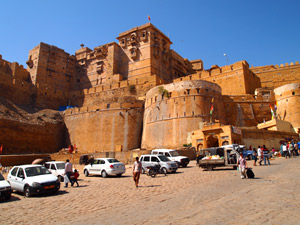 Jaisalmer Fort is one of the largest forts in the world. It is situated in Jaisalmer city in the state of Rajasthan. It was built in 1156 AD by the Bhati Rajput ruler Rawal Jaisal, from where it derives its name. The fort stands proudly amidst the golden stretches of the great Thar Desert, on Trikuta Hill, and has been witnessed many battles. Its massive yellow sandstone walls are a tawny lion color during the day, fading to honey-gold as the sun sets, thereby concealing the fort in the yellow desert. For this reason, it is also known as the "Golden Fort". This fort, popularly known as the 'Sonar quila' by the locals, is located in the very heart the city, and is one of the most breathtaking monuments in the locality.
Jaisalmer Fort is one of the largest forts in the world. It is situated in Jaisalmer city in the state of Rajasthan. It was built in 1156 AD by the Bhati Rajput ruler Rawal Jaisal, from where it derives its name. The fort stands proudly amidst the golden stretches of the great Thar Desert, on Trikuta Hill, and has been witnessed many battles. Its massive yellow sandstone walls are a tawny lion color during the day, fading to honey-gold as the sun sets, thereby concealing the fort in the yellow desert. For this reason, it is also known as the "Golden Fort". This fort, popularly known as the 'Sonar quila' by the locals, is located in the very heart the city, and is one of the most breathtaking monuments in the locality.
Major attractions in the fort are :
Best Time to Visit Mehrangarh Fort (Jodhpur) : October - March
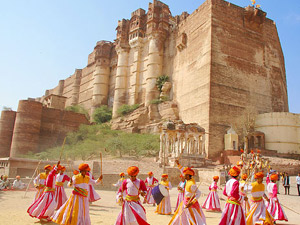 Mehrangarh Fort, located in Jodhpur, Rajasthan is one of the largest forts in India. The fort is situated 400 feet above the city and is enclosed by magnificent thick walls. Inside its boundaries there are several palaces known for their elaborate carvings and expansive courtyards. A twisting road leads to and from the city below. The imprints of cannonball hits by attacking armies of Jaipur can still be seen on the second gate. To the left of the fort is the chhatri of Kirat Singh Soda, a soldier who fell on the spot defending the Mehrangarh fort.
Mehrangarh Fort, located in Jodhpur, Rajasthan is one of the largest forts in India. The fort is situated 400 feet above the city and is enclosed by magnificent thick walls. Inside its boundaries there are several palaces known for their elaborate carvings and expansive courtyards. A twisting road leads to and from the city below. The imprints of cannonball hits by attacking armies of Jaipur can still be seen on the second gate. To the left of the fort is the chhatri of Kirat Singh Soda, a soldier who fell on the spot defending the Mehrangarh fort.
There are seven gates, which include Jayapol (meaning 'victory'), built by Maharaja Man Singh to memorialize his victories over Jaipur and Bikaner armies. Fattehpol (also meaning 'victory') gate was built by Maharaja Ajit Singh to mark the defeat of the Mughals. The palm imprints upon these still attract much attention even today.
The museum in the Mehrangarh fort is one of the most well-stocked museums in Rajasthan. In one section of the fort museum there is a selection of old royal palanquins, including the elaborate domed gilt Mahadol palanquin which was won in a battle from the Governor of Gujarat in 1730. The museum exhibits the heritage of the Rathores in arms, costumes, paintings and decorated period rooms.
Several brilliantly crafted and decorated palaces are found within the fort,. Of these, Moti Mahal (Pearl Palace), Phool Mahal (Flower Palace), Sheesha Mahal (Mirror Palace), Sileh Khana, and Daulat Khana are notable. One also finds the fort museum comprising several palaces. This museum houses an exquisite collection of palanquins, howdahs, royal cradles, miniatures, musical instruments, costumes and furniture. The ramparts of the fort are home to not only several excellently preserved old cannon but also offer a breath-taking view of the city.
Best Time to Visit Junagarh Fort (Bikaner) : October- March
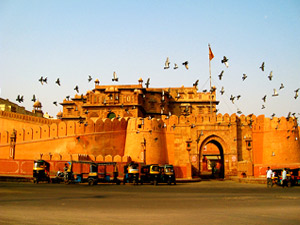 Junagarh Fort situated in Bikaner was built by Raja Rai Singh, in 1587. The fort is surrounded by a high wall and deep trenches. There are 37 bastions guarding the fort with only two gates as the entrance pathway to the fort, the main one being the Suraj Pol or the Sun Gate. The Junagarh Fort has yet been unconquered excepting the brief victory of Kamaran, which he could not retain for more than 24 hours.
Junagarh Fort situated in Bikaner was built by Raja Rai Singh, in 1587. The fort is surrounded by a high wall and deep trenches. There are 37 bastions guarding the fort with only two gates as the entrance pathway to the fort, the main one being the Suraj Pol or the Sun Gate. The Junagarh Fort has yet been unconquered excepting the brief victory of Kamaran, which he could not retain for more than 24 hours.
There are 37 red sandstone marvels inside the premises of the fort, which include palaces with intricately carved windows, beautiful balconies, towers , temples and pavilions. The highlights of the fort are Chandra Mahal, decorated beautifully with mirrors, paintings and carved marble panels, the Phool Mahal, the Karan Mahal and the multi-storeyed Anup Mahal, which was once used as the governance chambers for the rulers.
Ganga Niwas, Dungar Niwas, Vijai Mahal and Rang Mahal are also fine examples of the splendid architecture. The fort also houses a museum with an extensive collection of illuminated and rare manuscripts, jewellery, utensils, carpets, arms and weapons, treaties and other royal accouterments.
Famous Palaces
Best Time to Visit City Palace (Jaipur) : October - March
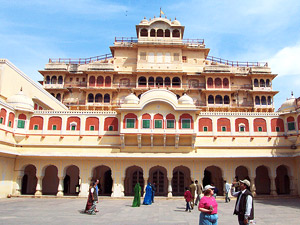 The palace complex lies in the heart of Jaipur city, to the northeast of the very centre. The site for the palace was located on the site of a royal hunting lodge on a plain land encircled by a rocky hill range, five miles south of Amber (city). The history of the city palace is closely linked with the history of Jaipur city and its rulers.
The palace complex lies in the heart of Jaipur city, to the northeast of the very centre. The site for the palace was located on the site of a royal hunting lodge on a plain land encircled by a rocky hill range, five miles south of Amber (city). The history of the city palace is closely linked with the history of Jaipur city and its rulers.
Maharaja Sawai Jai Singh II is credited with initiating construction of the city complex by building the outer wall of the complex spreading over many acres. Initially, he ruled from his capital at Amber, which lies at a distance of 11 km from Jaipur. He shifted his capital from Amber to Jaipur in 1727 because of an increase in population and increasing water shortage. He planned Jaipur city in nine blocks separated by broad avenues, on the classical basis of principals of Vastushastra and other similar classical treatise under the architectural guidance of Vidyadar Bhattacharya.
It is a unique and arresting complex of several palaces, pavilions, gardens and temples. The most prominent and most visited structures in the complex are the Chandra Mahal, Mubarak Mahal, Mukut Mahal, Maharani's Palace, Shri Govind Dev Temple and the City Palace Museum.
Best Time to Visit Hawa Mahal (Jaipur) : October - March
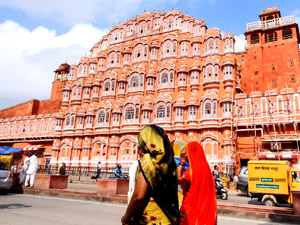 Built of red and pink sandstone, the palace is situated on the main street in the heart of Jaipur’s business centre. It forms part of the City Palace, and extends to the Zenana or women's chambers, the chambers of the harem. It is particularly striking when viewed early in the morning, lit with the golden light of sunrise.
Built of red and pink sandstone, the palace is situated on the main street in the heart of Jaipur’s business centre. It forms part of the City Palace, and extends to the Zenana or women's chambers, the chambers of the harem. It is particularly striking when viewed early in the morning, lit with the golden light of sunrise.
Maharaja Sawai Jai singh, the ruler of Rajasthan of the Kachwaha clan, was the original planner and builder who built the Jaipur city in 1727. However, it was his grandson Sawai Pratap Singh, who built the Hawa Mahal in 1799 as a continuation of the Royal City Palace.
The palace is a five-story pyramidal shaped monument that rises to a height of 50 feet (15 m) from its high base. The top three floors of the structure have a dimension of one room width while the first and second floors have patios in front of them, on the rear side of the structure. The front elevation, as seen from the street, is like a honeycomb web of a beehive built with small portholes. Each porthole has miniature windows and has carved sandstone grills, finials and domes.
The royal family ladies witnessed proceedings in the market centre and watch the royal processions and festivities sitting behind the stone carved screens. Hawa Mahal did just that in style, amidst its luxurious comforts and behind strict screened exclusivity, unseen by outsiders.
Best Time to Stay at Jai Mahal Palace: October- March
Jai Mahal Palace, the current residence of the royal Maratha family 'Scindia', is an Italianate structure combining the Tuscan and Corinthian architectural modes. About 35 of the rooms have been converted into the Scindia Museum. The main durbar hall is impressive.
The Jai Mahal Palace is an luxurious Italianate structure, set in carefully laid lawns. Built in 1809, this palace was designed by Lt. Col. Sir Michael Filose. In these rooms, so evocative of a regal lifestyle, the past comes alive.
The impressive Durbar Hall has two central chandeliers, weighing a couple of tones, and hung only after ten elephants had tested the strength of the roof. Ceilings picked out in gilt, heavy draperies and tapestries, fine Persian carpets, and antique furniture from France and Italy are some of its features.
Best Time to Stay at Umaid Bhavan Palace : October- March
Umaid Bhawan Palace, located at Jodhpur in Rajasthan, India, is one of the world's largest private residences. A part of the palace is managed by Taj Hotels. Named after Maharaja Umaid Singh, grandfather of the present owners of the palace, this monument has 347 rooms and serves as the principal residence of the erstwhile Jodhpur royal family.
Umaid Bhawan Palace was called Chittar Palace during its construction due to its location on Chittar Hill, the highest point in Jodhpur. Ground for the foundations of the building was broken on 18 November 1929 by Maharaja Umaid Singh and the construction work was completed in 1943.draft by Chatra Mohan Sharma chief draftsman in Indian railway.
At present the Palace is divided into three functional parts - a luxury Taj Palace Hotel (in existence since 1972), the residence of the erstwhile royal family, and a Museum focusing on the 20th century history of the Jodhpur Royal Family.
Best Time to Stay at Lal Garh Palace : October- March
This palace was constructed by Maharaja Ganga Singhji in respect of his father Maharaja Lal Singhji. The palace is a pretty recent construction (1902) and reflects a wonderful blend of three different style, Rajput, Mughal and European, which definitely deserves an appreciative glance. The regal red sandstone building with its overhanging balconies and refined lattice work radiates a classic beauty.
Step inside the palace to discover grand halls, lounges, cupolas and pavilions. Today, the palace boasts of a library that is regarded as the fourth largest in the world and a musuem (Shree Sardul Musuem) that showcases a wide variety of artifacts and personal possessions of Bikaner Maharaja.
Some of the interesting items on display are empty wine and sherry bottles; brass vessels known as tokna used to connect revenue in earlier days; an old film projector; personal belongings of Maharaja Karni Singh like golf tees, electric tooth brush, swimming goggles, earplugs and even his sneakers. The library too has a commendable or rather largest collection of original Sanskrit manuscripts on parchments, copper and gold or silver plaques.
Best Time to Visit Forts and Palaces of Rajasthan: October- March
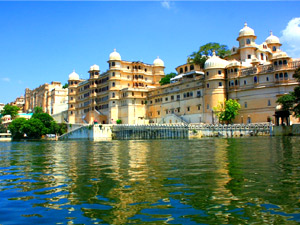 The City Palace in Udaipur was built in a glitzy style and is considered the largest of its type in Rajasthan, a fusion of the Rajasthani and Mughal architectural styles, and was built on a hill top that gives a panoramic view of the city and its surrounding, including several historic monuments such as the Lake Palace in Lake Pichola, the Jag Mandir on another island in the lake, the Jagdish Temple close to the palace, the Monsoon Palace on top of an overlooking hillock nearby and the Neemach Mata temple.
The City Palace in Udaipur was built in a glitzy style and is considered the largest of its type in Rajasthan, a fusion of the Rajasthani and Mughal architectural styles, and was built on a hill top that gives a panoramic view of the city and its surrounding, including several historic monuments such as the Lake Palace in Lake Pichola, the Jag Mandir on another island in the lake, the Jagdish Temple close to the palace, the Monsoon Palace on top of an overlooking hillock nearby and the Neemach Mata temple.
The Palace was built concurrently with establishment of the Udaipur city by Maharana Udai Singh II, in 1559 and his successor Maharanas over a period of the next 300 years. It is considered the largest royal complex in Rajasthan and is replete with history.
The famous structures or palaces viewed from the Lake Palace appear like a fort. They are interlinked inside the complex through a number of chowks or quadrangles with zigzag . Erected in the complex, after entering through the main Tripolia (triple) gate, are the Suraj Gokhda (public address facade), the Mor-chowk (Peacock courtyard), the Dilkhush Mahal (heart’s delight), the Surya Chopar, the Sheesh Mahal (Palace of glass and mirrors), the Moti Mahal (Palace of Pearls), the Krishna Vilas (named after Lord Krishna), Shambu Niwas (royal residence now), the Bhim Vilas, the Amar Vilas (with a raised garden) that faces the Badi Mahal (the big palace), the Fateprakash Palace and the Shiv Niwas Palace (the latest addition to the complex); the last two have been converted into heritage hotels.
The entire complex is the property of the Mewar royal family and a number of trusts take care of the running and maintenance of the structures. The earliest royal structure built in the complex was the Royal courtyard or Rai Angan.
D-21 Shiv Vihar,
Gandhi Path West
Jaipur-302021 (Rajasthan) India
Call : +91-97824 17111
Email:info@namasteholiday.com